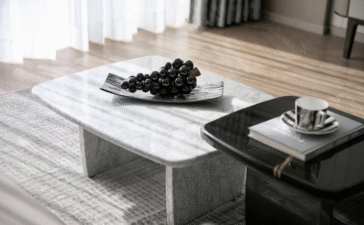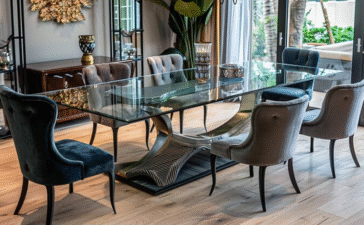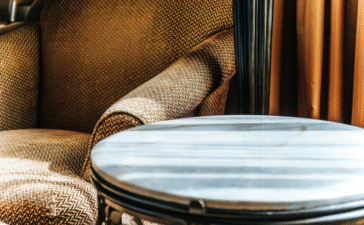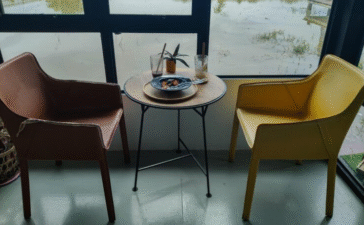A live edge coffee table does more than just hold your drinks and remote controls; it brings a piece of the natural world into your living room. Unlike mass-produced furniture with uniform lines, each live edge piece tells a story through its unique grain, knots, and curves. It’s a celebration of wood in its most organic form, offering a connection to nature that can ground any interior space.
This guide will walk you through everything you need to know about these stunning pieces of furniture. We will cover why a live edge coffee table might be the perfect addition to your home, exploring its design versatility, durability, and sustainable appeal. You will also find practical advice on different wood types, styling ideas, maintenance tips, and even how to create your own. By the end, you’ll understand what makes these tables so special and how to choose or build one that fits your style and values.
What Is a Live Edge Coffee Table?
A live edge coffee table is a piece of furniture that incorporates the natural, uncut edge of the wood slab from which it was made. Instead of being milled into a straight, conventional edge, the wood’s original contours, bark, and imperfections are preserved. This technique ensures that no two tables are ever identical. Each one is a unique design, showcasing the raw, rustic appeal of the tree it came from. The result is a stunning blend of natural art and functional furniture.
Why Choose a Live Edge Coffee Table?
The decision to bring a live edge coffee table into your home goes beyond simple aesthetics. These pieces offer a unique combination of style, durability, and a connection to sustainable design principles that resonate with modern homeowners.
The Appeal of Live Edge Furniture
The primary draw of a live edge table is its ability to seamlessly blend rustic charm with a modern aesthetic. The organic, flowing lines of the natural wood edge provide a soft, grounding counterpoint to the clean, sharp lines often found in contemporary and minimalist interiors. This creates a balanced and visually interesting space. Furthermore, as consumers increasingly seek out eco-friendly and sustainable furniture, live edge pieces made from reclaimed or responsibly sourced wood have become a popular choice. A 2023 report from the Sustainable Furnishings Council noted a significant rise in consumer demand for products with clear environmental benefits, a niche that live edge furniture fills perfectly.
Durability and Functionality
Live edge coffee tables are not just beautiful; they are built to last. They are typically crafted from thick, solid slabs of strong wood types like walnut, oak, maple, and cherry. This inherent strength makes them incredibly durable and resistant to the wear and tear of daily life. The robust construction ensures that your table isn’t just a fleeting trend but a long-lasting furniture investment. Their practical design allows them to function as a stunning centerpiece in a living room, a functional surface in a cozy reading nook, or even an unconventional statement piece in a creative office space.
Live Edge Coffee Table Design Ideas
One of the greatest strengths of a live edge coffee table is its versatility. It can adapt to and enhance a wide range of interior design schemes, from the starkly modern to the comfortably rustic.
Incorporating Live Edge Tables into Your Home Décor
Styling a live edge coffee table is about creating balance. In an industrial design setting, pairing a wood slab with bold metal legs can complement exposed brick and metal fixtures. For a minimalist furniture arrangement, a simple, unadorned live edge table can serve as the sole organic element, adding warmth and texture without creating clutter. Don’t be afraid to mix styles; a rustic live edge piece can add unexpected character to a formal living room or a touch of nature to a high-tech office.
Popular Shapes and Sizes
Live edge coffee tables come in a variety of shapes and sizes to fit different spaces and needs. Rectangular slabs are a classic choice for larger living rooms, providing ample surface area. Round or oval slices, often called “cookies,” work well in smaller areas or seating arrangements where traffic flow is important. There are also more abstract, freeform shapes that follow the tree’s natural growth. Many artisans also offer customizable tables, allowing you to specify the dimensions to perfectly suit your room.
Materials and Wood Types for Live Edge Coffee Tables
The type of wood you choose for your live edge coffee table has a profound impact on its appearance, durability, and cost. Each species offers a unique character.
Common Wood Types Used
Walnut is a highly sought-after choice for live edge coffee tables, prized for its deep, rich colors and complex grain patterns. It is a durable hardwood that resists warping. Oak coffee tables are another popular option, known for their prominent grain and exceptional strength, making them a very durable wood choice. Cherry offers a beautiful reddish-brown hue that deepens over time, while maple provides a lighter, more uniform color for a cleaner, more modern look.
The Impact of Wood Selection on Aesthetics
The visual identity of your table is defined by its wood. The wood grain can be straight, wavy, or burled, creating different visual movements across the surface. The wood color variations, from the pale sapwood to the darker heartwood, add depth and contrast. The table texture, whether sanded to a silky smooth finish or left more rugged, also plays a crucial role in its final appearance and feel.
DIY Live Edge Coffee Tables: Create Your Own
For those who enjoy a hands-on project, creating your own live edge coffee table can be an incredibly rewarding experience. It allows you to craft a piece of homemade furniture that is truly your own.
How to Make a Live Edge Coffee Table at Home
The basic steps for a DIY live edge coffee table involve sourcing a suitable wood slab, which you can find at local sawmills or online suppliers. Once you have your slab, you’ll need to flatten it, sand it smooth, and apply a finish. Tools needed typically include a planer (or a router with a flattening jig), sanders, and finishing supplies. There are many live edge table plans and online woodworking projects tutorials available to guide you. The final step is attaching legs, which can range from simple metal hairpin legs to custom-fabricated bases.
Live Edge Coffee Table Kits
If a full DIY build seems too daunting, live edge table kits offer a great compromise. These DIY woodworking kits usually come with a pre-flattened and sanded slab, legs, and all the necessary hardware and finishing oils. This simplifies the process, allowing you to focus on the enjoyable assembly and finishing stages.
Price Range and Where to Buy Live Edge Coffee Tables
The cost of a live edge coffee table can vary significantly based on several factors, but there are options available for a wide range of budgets.
Understanding the Cost
The main factors that influence live edge coffee table prices are the type and size of the wood, the rarity of the grain, the level of craftsmanship, and any customization. A small, simple table made from a common wood might cost a few hundred dollars, while a large, highly figured walnut or exotic wood table from a renowned craftsman can cost several thousand. Custom coffee table costs will also be higher due to the personalized labor involved.
Where to Buy
You can find high-quality live edge coffee tables from several sources. Reputable brands and furniture stores often carry a selection of tables. Online marketplaces like Etsy and Chairish are excellent places to find pieces from independent woodworkers across the country. For a more personal experience, consider visiting local woodworking shops or artisans, who can often create a custom piece just for you.
How to Care for Your Live Edge Coffee Table
Proper care is essential to preserve the beauty and longevity of your live edge table. With a little maintenance, your table will remain a stunning centerpiece for decades.
Cleaning and Regular Maintenance
For regular cleaning, simply wipe the surface with a soft, damp cloth. Avoid harsh chemical cleaners, which can damage the wood finish. To prevent scratches, use coasters and placemats. Minor scratches can often be buffed out with a bit of wax or oil, depending on the table’s finish. Proper live edge table care is key to wood protection.
Sealing and Protecting the Wood
Most live edge tables are sealed with a protective finish. Common wood finishes include oil, wax, or polyurethane. Oil finishes penetrate the wood to enhance the natural grain but may require periodic reapplication. Wax offers a low-sheen, natural feel. Polyurethane provides a durable, water-resistant topcoat that is very low-maintenance but can be more difficult to repair if scratched.
Customization and Personalization Options
One of the most exciting aspects of live edge furniture is the potential for personalization. Working with an artisan, you can create a custom coffee table that is a true reflection of your personal style.
You can select a specific slab of wood, choose the style of legs (metal, wood, acrylic), and decide on the final finish. Personalization ideas include having a name or date engraved, using colored epoxy resin to fill knots and voids, or choosing a unique stain to match your décor. This ability to create tailor-made furniture ensures your piece is one-of-a-kind.
The Sustainable Aspect of Live Edge Tables
In an era of increasing environmental awareness, the choices we make for our homes matter. Live edge furniture offers a compelling eco-friendly option.
Many live edge tables are made from sustainable wood, such as trees that have fallen naturally, been removed for urban development, or are salvaged from other sources. This practice of using reclaimed wood reduces waste and gives a new life to materials that might otherwise be discarded. By choosing an eco-friendly furniture piece, you are supporting environmentally conscious design and contributing to a more sustainable home.
Also Check: “marble coffee table“
A Timeless Piece of Nature in Your Home
A live edge coffee table is more than a piece of furniture; it’s a piece of art, a slice of history, and a nod to the beauty of the natural world. Its unique design, exceptional durability, and stylistic flexibility make it a worthy investment for any home. By embracing the imperfections and organic beauty of a live edge piece, you bring a timeless and grounding element into your living space that will be cherished for years to come.
Frequently Asked Questions
Are live edge coffee tables out of style?
No, live edge tables are not out of style. Their popularity has remained strong because they align with enduring design trends like biophilic design (connecting with nature), sustainability, and the appreciation for unique, handcrafted items. Their timeless appeal ensures they remain relevant in various design contexts.
What kind of legs go with a live edge coffee table?
A wide variety of legs can be paired with a live edge tabletop. Metal legs, such as steel trapezoids, U-shapes, or hairpin legs, are very popular and create a modern industrial look. Wooden legs can provide a more cohesive, traditional, or rustic feel. For a floating, ultra-modern appearance, clear acrylic or lucite legs are also an option.
How do you finish a live edge table?
Finishing a live edge table involves sanding the wood to a smooth surface and then applying a protective coat. The most common finishes are oil (like tung or linseed oil), hardwax oil, and polyurethane. Oil finishes enhance the natural grain and are easy to repair, while polyurethane provides a more durable, waterproof topcoat.
How thick should a live edge coffee table be?
A typical live edge coffee table slab is between 1.5 and 2.5 inches thick. This thickness provides a substantial, durable feel without being overly heavy or bulky. The ideal thickness can depend on the overall size of the table and the type of wood used.












